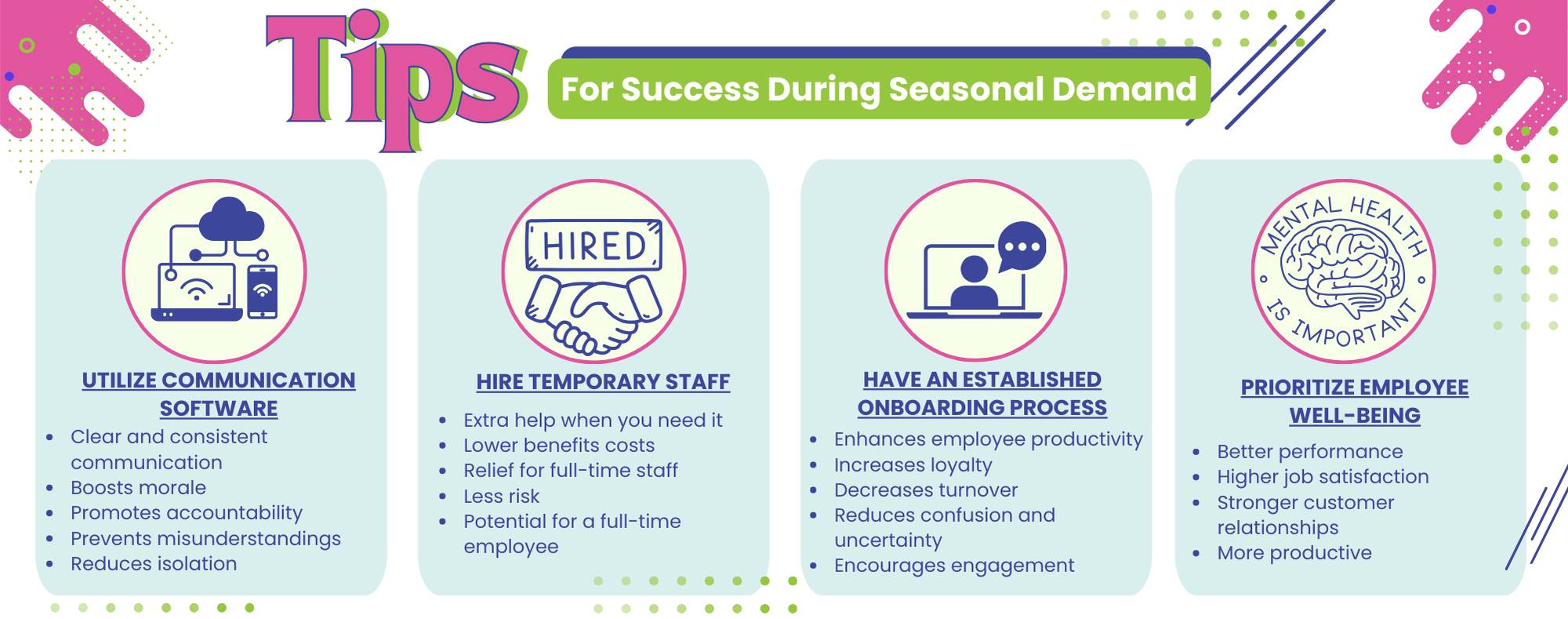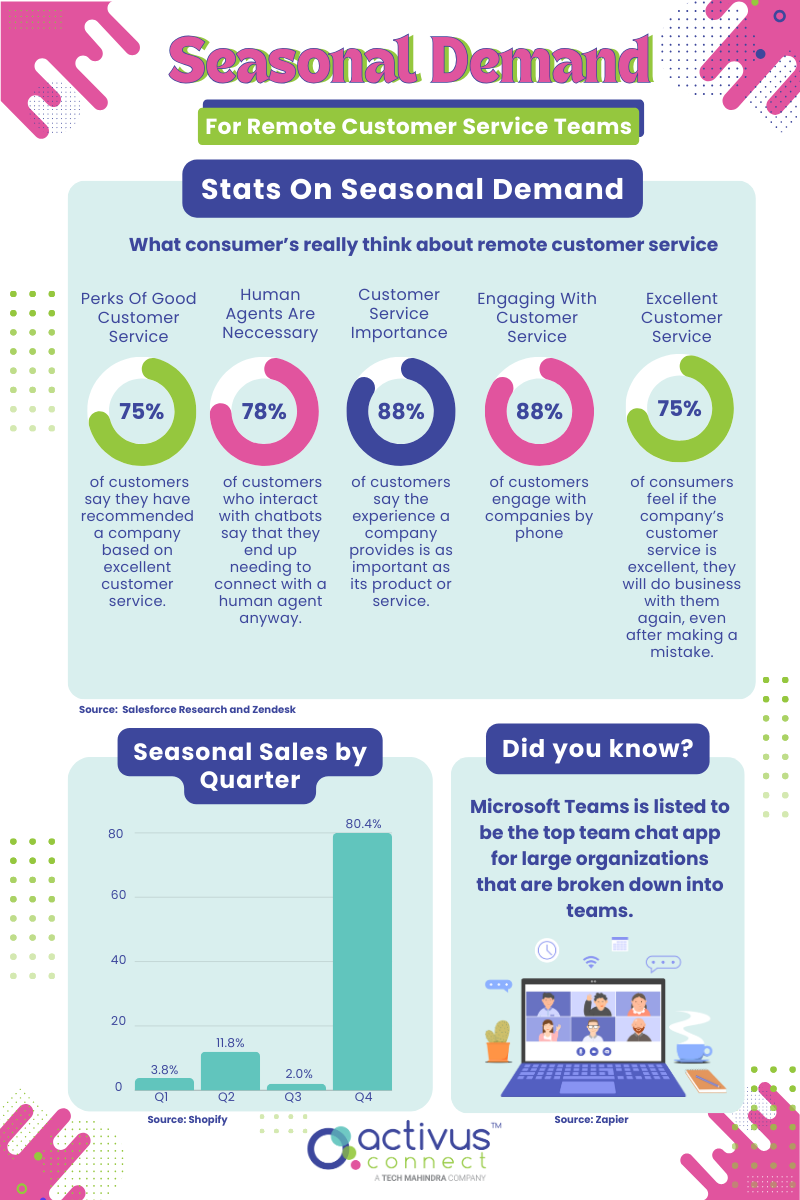
Struggling to keep up with customer service demands during peak seasons?
During high demand periods, customers expect fast response times, efficient problem solving, reliability and a convenient way to reach a representative to assist them.
Adapting to seasonal demand is crucial and if done effectively, adaptation can lead to increased customer satisfaction and higher revenue.
Customer service teams often face a unique set of challenges when adapting to a higher demand in a remote setting, and we are here to help.
Understanding Seasonal Demand
What exactly is seasonal demand?
Seasonal demand occurs when the need for a product or service spikes during specific times of the year.
Of course, the most talked about seasonal demand is the winter holidays. Thanksgiving, Black Friday, and Christmas are among the biggest seasonal demands in almost all customer service fields. People are shopping, traveling, hosting gatherings, providing meals to guests, and everything in between.
Summer, winter, and spring break can also be high-demand seasons, primarily for tourism and hospitality. Depending on the destination, these are times when people travel the most. Flights, rental cars, hotels, restaurants, and any tourist type activity will suddenly generate a high demand during these seasons.
Predicting and preparing for these demands by analyzing sales data, surveys and market research are essential for businesses to manage inventory levels, staffing, and marketing efforts in a way that will ensure they can meet their customers’ needs.
Check out these tips and strategies that help remote teams adapt to seasonal demand, boost performance, and maintain top-notch customer satisfaction, even during the busiest times of the year!

Effective Communication Strategies
Clear and consistent communication withing remote teams should be a high priority as it directly impacts team performance, productivity, and morale.
Research by Gallup shows, on average, that teams with managers who meet with their employees regularly almost tripled their level of engagement compared to teams with managers who don’t meet with their team regularly.
Establishing regular meetings or check-ins with the team is critical to staying aligned on goals and challenges. It helps promote accountability, prevents duplicated efforts and misunderstandings, and reduces isolation.
Overall, it creates a positive work culture and keeps everyone on the same page.
Apps like Microsoft Teams, Zoom, Slack and Discord make it easy to host video team meetings, collaborate on tasks and chat throughout the day about any issues or to stay updated on each other’s progress
Scaling Up: Hiring Temporary Staff
As stated previously, customers expect faster responses during peak periods. This is where temporarily hiring additional staff comes into effect.
Hiring temporary staff allows businesses to quickly scale their workforce ensuring they have enough resources to handle the increased volume to meet demand spikes.
Recruiting, training, and integrating temporary staff into remote teams can be challenging, but with the right approach, the process can run quite smoothly.
Businesses can utilize recruitment platforms like staffing agencies or remote job boards to help find temporary or seasonal workers, especially those experienced in customer service or remote work.
Having an established onboarding process with pre-recorded training videos, hands-on training with mentors, or interactive training sessions helps make training the new workers a smooth and efficient task.
Although integrating temporary staff into ongoing projects can be a delicate process, an article on Linked In states that providing them with opportunities to collaborate with permanent team members helps them understand the bigger picture and how their work fits into it.
Prioritizing Employee Well-being
Seasons of high demand often bring increased workloads, higher stress and more pressure, which can significantly impact an employee’s well-being.
According to Lrya’s “A Manager’s Guide to Preventing Employee Burnout”, the number one way to help retain employees and keep them engaged is to adopt an overall strategy to support mental health in the workplace.
By prioritizing mental health and taking proactive steps to prevent burnout, remote customer service employees can maintain their well-being, resulting in better performance, higher job satisfaction and stronger customer relationships.
Which, in return, leads to a healthier, more productive work environment even during the most demanding time.
Simple things like encouraging regular breaks, implementing flexible work schedules, hosting workshops, and rewarding hard work to keeping our mental health in tiptop shape.
Continuous Improvement and Feedback
By analyzing historical demand data such as patterns in volume, seasonal trends and identifying peak periods, companies can make data-driven decisions that improve efficiency, customer satisfaction and employee well-being during seasonal demands.
Encouraging team feedback offers valuable insights into operational challenges and opportunities for growth.
Team members are most likely to share honest feedback when they feel safe from judgment or negative consequences. Providing a safe, open-door policy creates a space where employees can share their honest thoughts, concerns, and ideas knowing that their feedback is valued and won’t be met with criticism.
Businesses can create continuous improvement by making little changes regularly based on team feedback. This shows the employees that their opinions and suggestions are being heard.
 In conclusion
In conclusion
Adapting to seasonal demand is essential for the success of remote customer service teams. By anticipating fluctuations in customer needs and implementing these strategies, companies can provide quality service during high demand seasons.
Ultimately, by staying proactive to seasonal demand, remote customer service teams can deliver outstanding support and uphold customer loyalty year-round.
We encourage you to implement these tips to help your team adapt effectively in these high-demand seasons. By applying these strategies discussed, you can improve team efficiency, enhance customer satisfaction, and navigate peak periods with confidence.
We’d love to hear how these approaches work for you! Please share your experiences, insights, and any additional tips in the comments below. Your feedback could help others facing similar challenges.
—
Contact us at Activus Connect for help elevating your customer’s experiences!